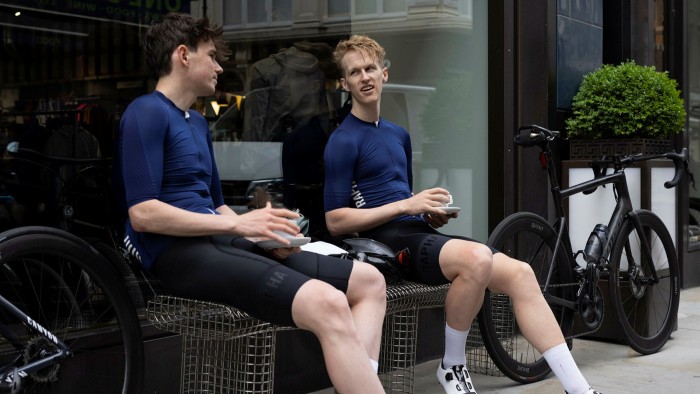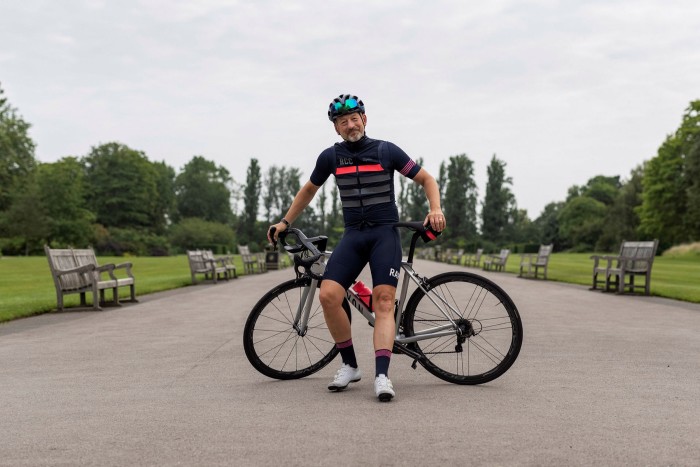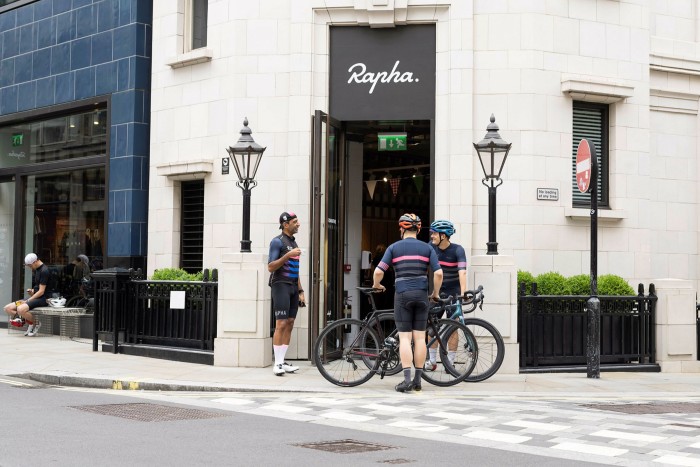Cycling offers ever more expensive ways to exercise and socialise


Roula Khalaf, Editor of the FT, selects her favourite stories in this weekly newsletter.
On a post-rain summer morning in Regent’s Park, central London, Katherine Clarke’s eyes burn with enthusiasm. Among a crowd of about 100 members of a cycling club gathered near the middle of the park, she stands astride her Giant TCR bike. There are some older riders but most, like Clarke, are early-career professionals, immaculate in their smart but expensive Rapha kit, the cycling clothing brand that runs their club. The riders head off in small bunches on one of the club’s weekly rides around the park.
Clarke’s enthusiasm is widely shared. The number of miles cycled on UK roads in 2020 was up 46 per cent on the previous year. Amid the Covid-19 pandemic, cycling benefited from nervousness about the risks of public transport and from being one of the few permitted ways to exercise during lockdown.
Clarke, who works for a private equity firm, says cycling offers “so much freedom”. “It’s social,” she adds. “There’s nothing better than going out exploring, going to have a coffee and then chatting bike. It encompasses everything.”
Yet the club’s riders do not take their spins round the park lightly. Many of their wheels emit a hollow rumble that marks them out as carbon fibre, costing as much as £2,000 a pair. Although Clarke bought her bike second-hand, she describes it as “fairly fancy”, featuring a light, carbon-fibre frame and hydraulic disc brakes.

Simon Mottram, Rapha’s chief executive, says on-road sport riding is attracting as much interest as the use of bikes purely as transport. “We’re more than 50 per cent up in sales this year,” Mottram says, speaking from the Rapha “clubhouse”, a café and shop near Regent’s Park where riders socialise after their laps. That growth has come from existing customers but also from a “huge” number of new ones, he says.
Rapha’s club members are the brand’s “most engaged customers”. The typical member is a “very active cyclist”, he adds. The club offers a range of long rides into the countryside and overseas trips, and it is clear from the post-ride buzz at the clubhouse that it plays a central role in the social lives of many riders. Mottram reports that the company is seeing similar growth in many of its 19 stores across Europe, North America and Asia Pacific. Sales in New York are up 50 per cent year on year, as they are in London. “I cannot imagine a company or an industry that has more positive trends behind it than cycling,” he says.
Such optimism is understandable at the Roehampton Café in Richmond Park, south-west London, one Saturday morning. The café is surrounded by scores of riders in Lycra skinsuits on bikes formed from carbon-fibre or titanium. Some will have cost £5,000 or more.
Many riders wear the blue-and-black colours of London Dynamo, a 600-member club. Riders complete four loops of the park — a total of 26 miles — in preparation for group rides into the countryside surrounding London, such as the Surrey hills and the North Downs.
David Stroud, the club’s race events secretary, insists the sport is egalitarian, despite the high cost of some machines. “It’s very levelling,” he says. “What I love about people cycling is we can have a plasterer and a head of a private equity firm riding all together.”
Other forms of riding are also growing. Joe Nocella, owner of the 718 Cyclery, which supplies tailored bikes in Park Slope, Brooklyn, says he has seen strong demand from people spending $2,000-$3,000 on robust bikes equipped with racks and mudguards. The buyers intend them as all-purpose tools for everything from commuting into Manhattan to carrying camping gear.
He says there would be enough demand for him to make a weekly event of the occasional weekend adventure trips he organises, leaving lower Manhattan on a Saturday morning. Participants ride between 40 and 60 miles to campsites north of the city, then back on the Sunday.

Will Pearson, director of Pearson Cycles, a London-based supplier of high-end bikes, says he has experienced rising demand for gravel bikes, set up to handle rough, off-road tracks as well as roads. The company quickly sold out of a new £6,300 titanium-framed gravel bike called Summon the Blood when the easing of lockdown travel restrictions made road riding less attractive. “The beauty of gravel riding is that people could get off the roads as they began to get busier and into fresher air,” Pearson says.
However, he does believe that the costs impose limits on who can participate. “It’s not a cheap hobby,” says Clarke.
Fashion clearly drives some of the spending. Pearson acknowledges there is “one-upmanship . . . to a degree” in some purchases. That helps him to sell products such as the Objects in Motion titanium-framed road bike. It features electronic gear-shifting, carbon-fibre wheels and hydraulic disc brakes, for around £7,000. People buy such machines to avoid being left behind, he says. “The newer machines are typically more efficient.”
Yet the riders’ enthusiasm defies most cynicism. In Regent’s Park, Peter Lacey, a retired police officer, explains how, having competed internationally as an amateur in the early 1970s, he rediscovered the sport through cycling with other enthusiasts. “I find it a . . . new lease of life . . . coming back riding with these guys from all over the world.”
Robert Wright is the FT’s social policy correspondent. Follow Robert on Twitter
This article is part of FT Wealth, a section providing in-depth coverage of philanthropy, entrepreneurs, family offices, as well as alternative and impact investment
Comments